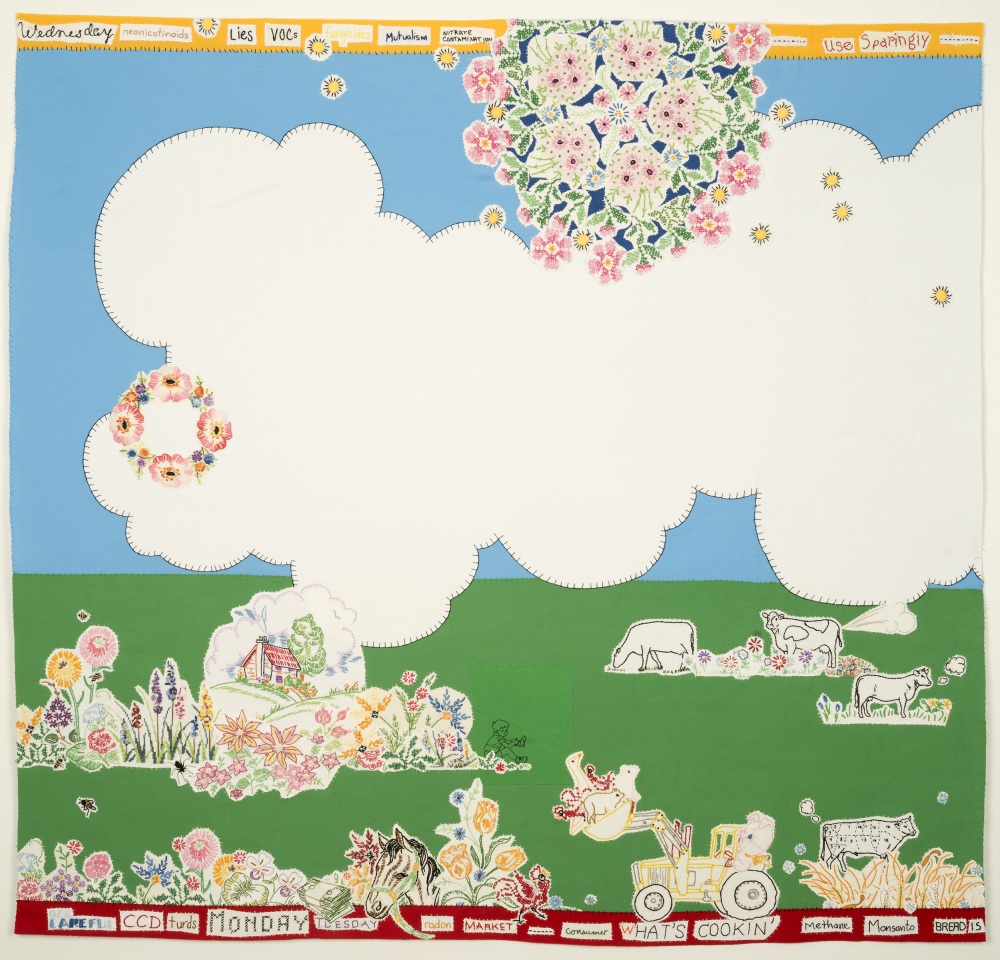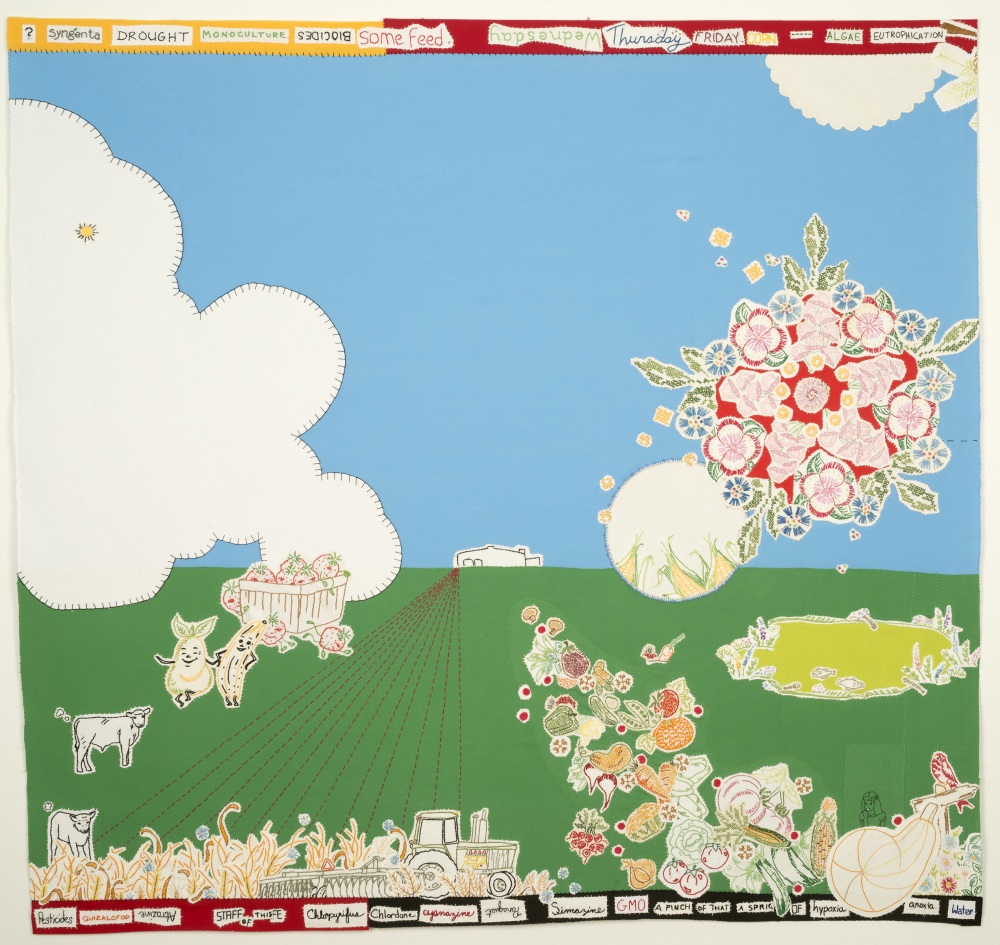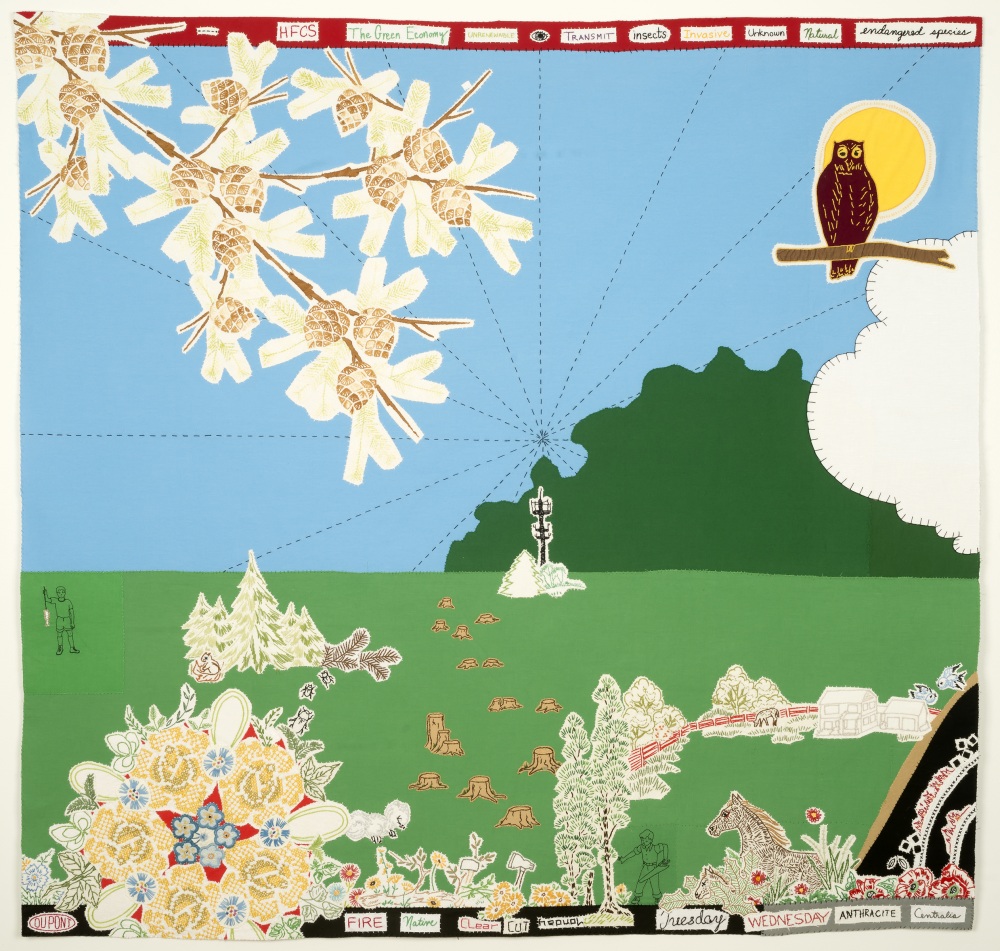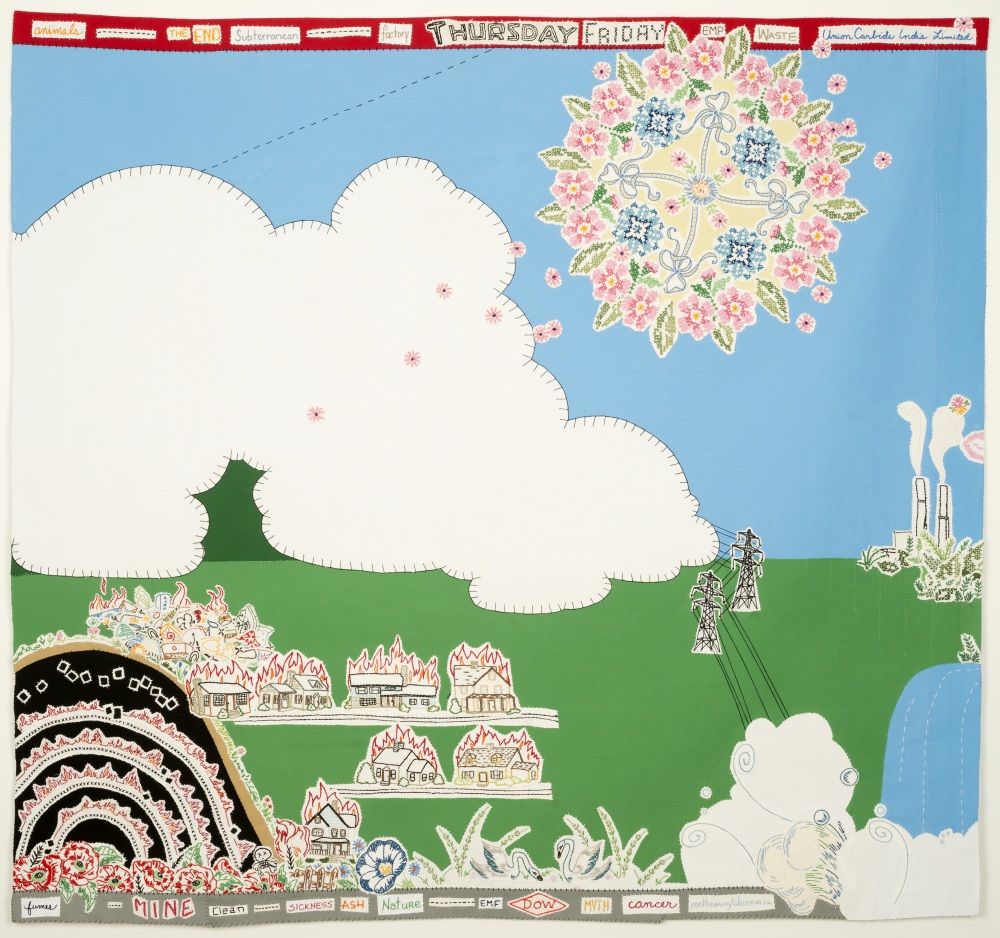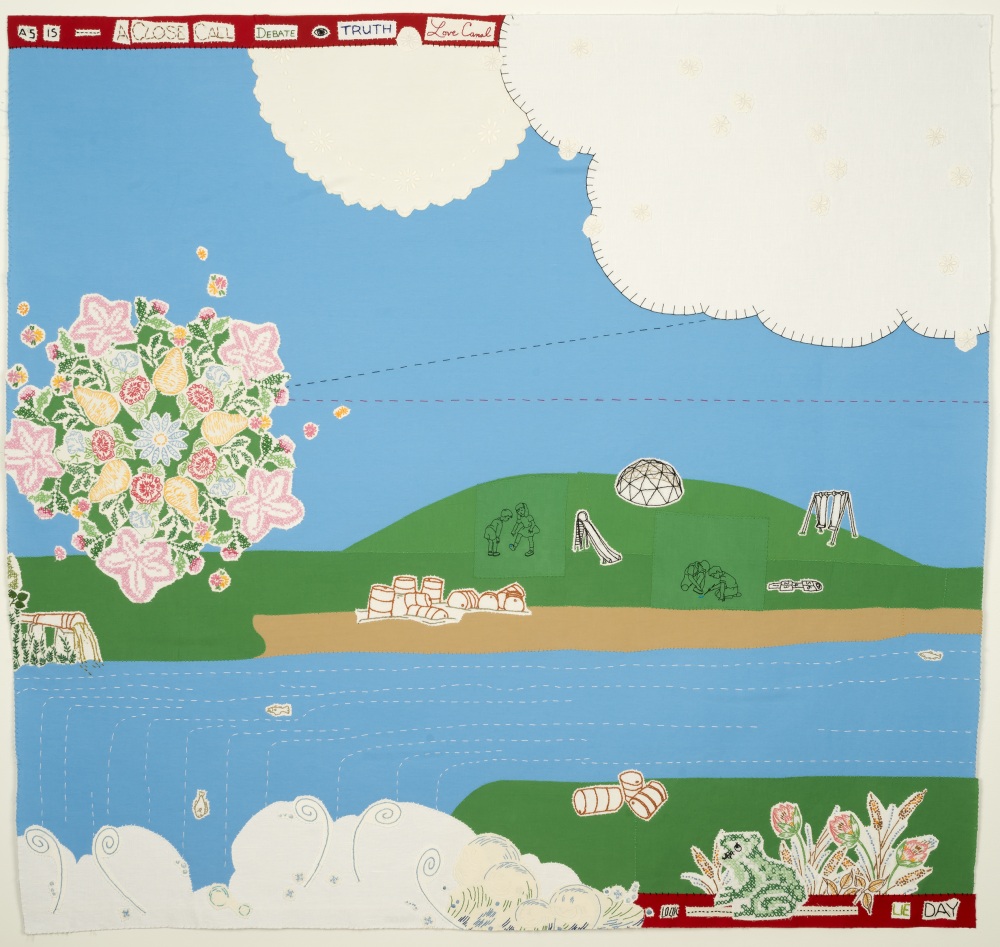Maggy Rozycki Hiltner: Vantage Point
Monday, October 7, 2019 to Friday, February 14, 2020
The gallery will be closed December 21, 2019 through January 1, 2020 and January 20, 2020.
The University of Nebraska’s Robert Hillestad Textiles Gallery will feature the exhibition Maggy Rozycki Hiltner: Vantage Point, October 7, 2019 – February 14, 2020.
In April 2014, Maggy Rozycki Hiltner was selected to create an installation for the Mesa Contemporary Arts Museum’s Dr. Ruth Tan Lim Project Room. As an embroidery artist, filling 72 linear feet of wall space with hand-stitched imagery would be her largest project to date. She began by designing an idealized landscape with a big blue sky, green grass, and puffy white clouds. Researching ways of depicting cloud forms led her to thinking about clouds as water vapor and then water vapor as greenhouse gas. And other clouds— volcanic plumes, mushroom clouds, emissions from factories and puffs rising from the cooling towers of nuclear reactors—drew her attention as well. The resulting piece, Vantage Point, traveled from Mesa to other venues, changing shape to fit each one. In 2018, Hiltner stitched an additional 39 linear feet to make the piece site-specific for the Holter Art Museum in Helena, Montana.
Maggy Hiltner’s previous work centered on intimate figurative narratives, Dick-and-Jane style kids in semi-autobiographical scenes from her childhood. She was raised in Pennsylvania— the land of coal and steel and industrial waste. The more she researched, the more she knew she had to include pollution, both seen and unseen, from her personal landscape.
Hiltner grew up in the 10-mile evacuation radius of Limerick Generating Station, a nuclear power plant in Pottstown, PA. The Limerick towers could be seen from the windows of her middle school classroom. Maggy Hiltner and her friends swam in the bathtub-warm water downstream from the power plant. “The Schuylkill River, once dubbed America’s foulest river, was cleaned up in the 40’s and 50’s—this meant the coal silt was dredged from the river and dumped in an area we kids would later call ‘The Black Desert’,” said Hiltner. “After a day of riding our bikes through the Black Desert, we had to hose off the black silt before we’d be allowed in the house. On Thanksgiving trips to Grandma’s, my father would make a short detour through Centralia, so the family could check on the progress of the underground coal fire that had been burning there since 1962.” These troubling exposures have colored Hiltner’s adulthood and her creative output.
Maggy Hiltner set herself to stitching natural and manmade disasters into her landscapes as she continued to research these ecological problems. Maps and illustrations drew Hiltner to include portolan lines and vanishing points—adding movement and a linear design element and poking fun at her tendency towards flat representation. “I included found embroidery cut from countless tablecloths and handkerchiefs” and the artist generated a list of terms and places picked up from headlines, news stories, and research. This text became a news ticker above and below, informing the individual scenes. The world Hiltner visualized is still beautiful, but the impact of human consumption and waste is everywhere.
Hiltner searches antique shops, thrift stores and yard sales for embroidered linens, collecting the brightly colored flowers, foliage, and animals that appear in her work. What she cannot find she hand-stitches and mixes in with the collected embroidery. She uses the familiarity of the stitch along with seemingly lighthearted and cheerful designs to convey more serious subject matter. She often uses humor and Dick and Jane-style characters to tell her stories, and very rarely is everything quite what it seems.
Maggy Rozycki Hiltner is a full-time studio artist and activist living in Red Lodge, MT. She comes from a family of makers: her mother and grandmothers needlepointed pillows, made quilts and stitched or knitted their clothes and toys; her father built odd things and cooked what she describes as “outrageous meals”, and painted murals in their home.
The Hillestad Gallery is located on UNL’s East campus, on the second floor of the Human Sciences Building , 1650 N. 35th St. It is open 8:30 a.m. to 4:00 p.m. Monday through Friday and by appointment. Admission is free. Guest parking is available near the Human Sciences Building and in metered stalls in the Nebraska East Union lot. For more information, visit http://textilegallery.unl.edu or call 402-472-2911.
Note: The panels are clued in the tickertape of information at the top and bottom of the panel, and then many of those terms are explained in the glossary.
Related Stories:
Artist displays alarming environmental trends through hand-stitched exhibit, Daily Nebraskan, October 8, 2019, Allyssa Gutierrez.
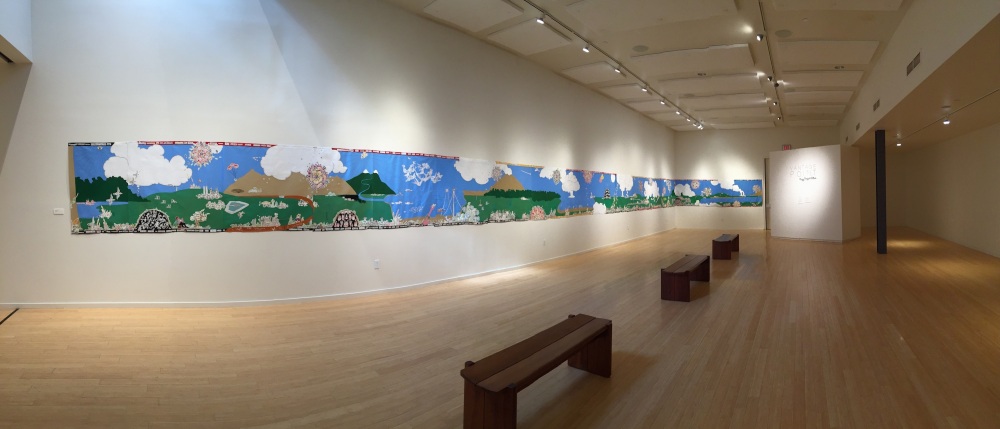
Installation view: Lawrence Arts Center, Lawrence, Kansas. 2016.
